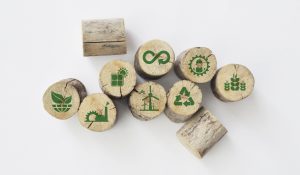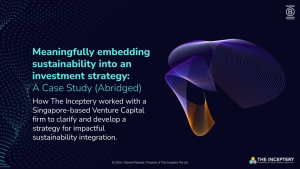The Need: changes in legislation, illegal logging, climate change, customer demand, and waste wood that cost a few hundred thousand dollars a year – these were the reasons why the founder of LHT Holdings decided to do things differently.
The Solution: Innovation mindset and environmentally-friendly strategy to grow and differentiate the company. Transformation of waste to worth and offering a superior product at competitive prices. Shared value for all stakeholders: employees, environment, and shareholders.
The Challenges: Market acceptance, influencing customers for a mind change, waste scarcity.
The Benefits: Innovation opportunities: new products and innovative business models, competitive advantage through efficiency, and cost savings.

About the company/ Background
LHT Holdings Ltd started in 1977 as a sawmill, which made wooden pallets from natural timber. The company was listed on the stock exchange in 1999.
Over the years they have become manufacturers of not only wooden pallets of various sizes but also boxes, crates, flooring, and furniture components. Their services include logistics support, waste disposal, industrial packaging, and pallet rental services.
In the beginning, when Singapore was in the midst of growth, manufacturing regulation was loose. However, around the year 2000 with continuing business pressures, concerns for the environment (illegal logging, climate change), and customers starting to demand more from the manufacturers to improve and upgrade their practices and their products – the company’s management decided to do things differently, more responsibly. Their disposal practice used to cost the company a wasteful S$300K a year.
From waste to worth
To eliminate illegal logging, and address climate change and the costly waste disposal practice, the founder of the company Mr Neo tapped into other countries’ know-how for recycling solutions. The first waste wood recycling facility (based on German technology) was installed in 1999. This was a high-heat technology and high compressor facility that produced strong, high-density Technical Wood. It is chemical and pest resistant, fire retardant, and is low in moisture content, used to manufacture a wide range of specially designed wooden products. Not only were the new products environmentally friendly, but also redesigning and re-engineering the process helped to reduce the number of steps in the manufacturing process by half, which was reflected in cost savings. The factory site is now also a zero-waste site.
Innovative products and services
The year was 1999 and market conditions were unfavorable for innovation. The company leadership made a bold decision to give pallets for a free trial to a number of small companies. These companies used the product for export and consequently, other companies became exposed to LHT and its products.
Drivers for change were climate change and now the Paris Agreement, which brought wider awareness about sustainability. Regulation in international guidelines for waste packaging material provided yet another opportunity. LHT has created a new product through innovative processes – a pest-free pallet. Initially, their customers were reluctant to change and preferred to buy cheaper pallets. Until they encountered additional costs due to pests found in these pallets. Nowadays, LHT supplies ~ 70% of the pallets in the market through their pallet leasing model.
Utilizing the in-house surplus of materials and technologies, the company seized the opportunity to create different products (packaging, furniture components, and fire-rated doors) and enter new markets. They also created innovative Laminated Veneer Lumber (LVL) products made of wood shavings, thus using less natural wood and reducing wood wastage. Long pieces of 1.7 meters LVL are used for solar panels, the petrol chemical, pharmaceutical, electronic and biomedical sectors, and for air and sea packaging. These products are energy efficient and don’t require new solid wood, and the “product as a service” business model ensures long product life and cost-effectiveness.
Moreover, the company has an arm of waste wood and wood chips recycling called LHT Eco-Tech Resources – an official NEA-licensed collector. Singapore’s regulation discourages industrial waste disposal by charging S$77 per ton, not including transportation and other costs. Downstream wood and horticultural waste is converted into wood Biomass for energy plants.
Curiously, one of the challenges now is a more limited supply of wood waste. This is because other companies have adopted the same approach and are using waste wood as a resource. Innovation must be contagious!
Innovation for LHT is..
Mindset, but also market acceptance. At LHT, top management drives innovation with skills, experience, and knowledge of the market. However, the people on the ground voice their ideas, they are the ones who are “hands-on” and have unique perspectives of all activities. In order for true innovation to take place, everyone needs to be involved to provide a broad understanding of the entire system and be open to experiment.
There are many drivers for innovation: Sometimes it is because there is a roadblock to business-as-usual; in Singapore, it is also driven by government initiatives and a customer-centric outlook, where LHT followed their customers’ needs and requirements resulting in the implementation of the innovative business model of pallet renting.
Mr. Thomas Yeo elaborates: “As an SME we need to be cost-effective, which in turn drives innovation. For large companies, it is more complicated because they are long-running and have deeply ingrained practices thus the gap is large and it is difficult to know where to start. From this perspective, a small company has an advantage”.
Challenges
Singapore market is challenging for recycling businesses:
1) Recycling equipment requires high capital investment (accounted for a million dollars).
2) It requires a large land area for storage of waste materials, the layout of recycling equipment, commercial tippers/trucks lanes for conveying, and storage space for final products and/or by-products. Singapore is land scarce and tenure lease of commercial land is costly and impermanent. With a large upfront financial investment, ROI is possible after 10-15 years.
3) Need to invest in market education and mindset shift as only when there is market acceptance, profit from waste materials products is possible.
Economic, social, and environmental benefits
Due to particular difficulties to compete in the ASEAN market, for LHT, sustainability became a necessity. Incorporating sustainability into their business, allowed the company to cut operating costs of raw materials and processing, turning savings into profits.
Sustainability drives their product, service, and business model innovation. The company has a problem-driven, responsive approach: “Sharing Mondays” is where employees bring on their ideas and suggestions. Through their commitment to inclusion of marginalized groups, the company supports many elderly in their need for work and many have worked there for years. These workers are highly knowledgeable in what they do and their ideas are listened to and implemented where possible. There is no specific ethos for this kind of social awareness, it is all about work culture. However, it is also driven by difficulty to find workers for these jobs and regulations that made it difficult to employ foreigners.
Additionally, studies have shown that women executives are having a real impact in protecting shareholder investment and overall firm performance. While only 14.7 percent of women hold board seats in Singapore companies in 2018 (up from 9.5 percent in December 2015), in February 2017 LHT board members appointed Ms Mui Kee Yap in the leadership position of the company as Chairwoman, CEO & MD.
Through their activities, LHT provides ~ 1,800 tonnes of wood chips (crushed from wood waste) for biomass to a power plant and consumes ~ 1,000 tonnes of wood chips (crushed from wood wastes) for Technical Wood production every month, thus eliminating over 33,000 tonnes of wood and horticultural waste to landfill.
Growth and profitability for LHT
Whilst “being profitable” still means increasing market share and revenue, it is up to us – citizens and businesses – to figure out how to sustain ourselves profitably and responsibly.
It is expected that every year a company will grow at least by 5% in terms of revenue. This can only happen if the company expands or increases productivity by 2-3 times by implementing new technology. LHT is doing both, expanding to ASEAN markets and implementing new technologies as well as new business models.
LHT is committed to continuing its journey to become a greener and smarter manufacturer. The company is in the process of developing a smart factory to counter the difficulty of finding workers for repetitive work, the need for higher efficiency and productivity, alongside the need for automation. The company is transforming to a smart factory 4.0, which will help position LHT ahead of other market players in its competitive edge.






